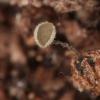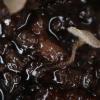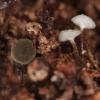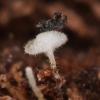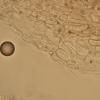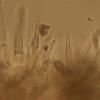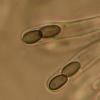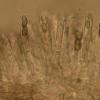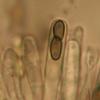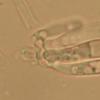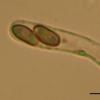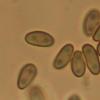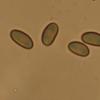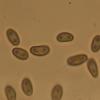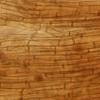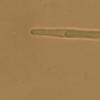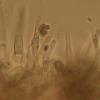
29-12-2025 17:44
Isabelle CharissouBonjour,J'aimerais savoir si d'autres personnes au

29-12-2025 17:12
 Bernard CLESSE
Bernard CLESSE
Bonjour à toutes et tous,Pourriez-vous m'aider à

12-11-2021 00:03
Lepista ZacariasHi everybody,A week ago in my fiels trip I noticed

29-12-2025 17:01
Gernot FriebesHi,I'm looking for help with this hyphomycete with

29-12-2025 08:30
Hello.A tiny ascomycete sprouting under Juniperus

29-12-2025 10:15
Hulda Caroline HolteHello, I found and collected this propoloid ascom

29-12-2025 09:38
Oskari VirtanenHi,could anyone help me identify this, I suspect P

28-12-2025 12:08
Margot en Geert VullingsThis possible Karstenia was found on the bark of d
Martininia with bisporic asci?
Zuzana Sochorová (Egertová),
01-05-2025 20:11
 Hello,
Hello, today I have collected a tiny ascomycete growing on a very decayed Fagus wood partly mixed with some excrements.
It looks like Martininia panamaensis, but the asci are mostly 2-spored, only rarely 3-spored.
There was described M. tetraspora, which was later combined as M. panamaensis f. tetraspora. So, maybe there is also bisporic form?
Ascospores in my collection measure (4.5) 4.7-5.3-5.9 (6.2) × (2.4) 2.5-2.7-3 (3.1) µm, Q=(1.65) 1.71-1.96-2.22 (2.57), n = 50.
Asci H+, IKI-, (23.9) 25.3-27.80-30.2 (32.9) × 3.9-4.2-4.5 µm.
It´s from Moravia (Czech Republic).
Thank you, Zuzana
Zuzana Sochorová (Egertová),
01-05-2025 20:23
Hans-Otto Baral,
01-05-2025 20:47

Re : Martininia with bisporic asci?
Very interesting collection, surely a Martininia! According to photos by Jean-Claude Chasle from 2019, M. panamaensis has the very same hairs and VBs within. Regarding bisporous asci I only know "Hymenoscyphus" kermesinus. with hyaline spores and a globulosa, possibly related to Sclerotiniaceae s.str., while Martininia seems to be more close to Rutstroemia or Lambertella.
Zuzana Sochorová (Egertová),
02-05-2025 14:11

Re : Martininia with bisporic asci?
Thank you very much.
Maybe I will let it sequenced.
It´s interesting that the other collection here at AscoFrance (by Valencia Lopez) has so much larger spores than others ((7,13) 7,56 - 9,31 (14,18) × (3,83) 4,20 - 4,91 (5,21) µm).
Maybe I will let it sequenced.
It´s interesting that the other collection here at AscoFrance (by Valencia Lopez) has so much larger spores than others ((7,13) 7,56 - 9,31 (14,18) × (3,83) 4,20 - 4,91 (5,21) µm).
Hans-Otto Baral,
02-05-2025 20:27

Re : Martininia with bisporic asci?
Yes, they are 7-9 x 4-5, while M. panamensis has 4-5 x 2-3.
Valencia Lopez Francisco Javier,
04-05-2025 19:12
Re : Martininia with bisporic asci?
Hola a todos
Que especie más interesante, como comentáis parece que existen formas con ascas octosporicas, tetrasporas y ahora bisporicas, también las ascas de esta especie bisporica se ven muy diferente y muchos más pequeñas que mí colección.
Será interesante ver lo que dice la secuencia
Saludos
Curro Valencia
Que especie más interesante, como comentáis parece que existen formas con ascas octosporicas, tetrasporas y ahora bisporicas, también las ascas de esta especie bisporica se ven muy diferente y muchos más pequeñas que mí colección.
Será interesante ver lo que dice la secuencia
Saludos
Curro Valencia
Zuzana Sochorová (Egertová),
04-05-2025 20:35

Re : Martininia with bisporic asci?
Hi Curro,
hopefully sequencing will be successful - the material is limited, as the apothecia are really very small. I spent most of the weekend observing this fungus, and finally found two tetrasporic asci (with hyaline spores), but the majority really was bisporic, some trisporic.
Do you have a sequence of your collection for comparison?
Best regards, Zuzana
hopefully sequencing will be successful - the material is limited, as the apothecia are really very small. I spent most of the weekend observing this fungus, and finally found two tetrasporic asci (with hyaline spores), but the majority really was bisporic, some trisporic.
Do you have a sequence of your collection for comparison?
Best regards, Zuzana
Hans-Otto Baral,
04-05-2025 20:50

Re : Martininia with bisporic asci?
I wonder about the nuclear division in the asci with these different spore numbers. Possibly the spores are too small to see nuclei, and probably only as long as the spores are hyaline. I cannot see any aborted spores.
Valencia Lopez Francisco Javier,
05-05-2025 18:28
Re : Martininia with bisporic asci?
Hola Zuzana
Desgraciadamente no tengo secuencia de mi colección, tambié fue una recolección muy pobre y apenas me quedó material para el herbario, seguiré buscando.
Suerte con tu colección.
Saludos
Curro Valencia
Desgraciadamente no tengo secuencia de mi colección, tambié fue una recolección muy pobre y apenas me quedó material para el herbario, seguiré buscando.
Suerte con tu colección.
Saludos
Curro Valencia
Peter Welt,
05-05-2025 19:25

Re : Martininia with bisporic asci?
Very interesting. The species is also described by Dung, but it's very, very rare.
Peter
Zuzana Sochorová (Egertová),
05-05-2025 20:28

Re : Martininia with bisporic asci?
Unfortunately I wasn´t capable to observe nuclei. Hopefully this could be solve employing DAPI (which I don´t have but some friends do).
Zuzana Sochorová (Egertová),
05-05-2025 20:45

Re : Martininia with bisporic asci?
Probably it´s difficult to spot - my apothecia were rather hidden and very small (with disc of many of them measuring only around 0.5 mm).

